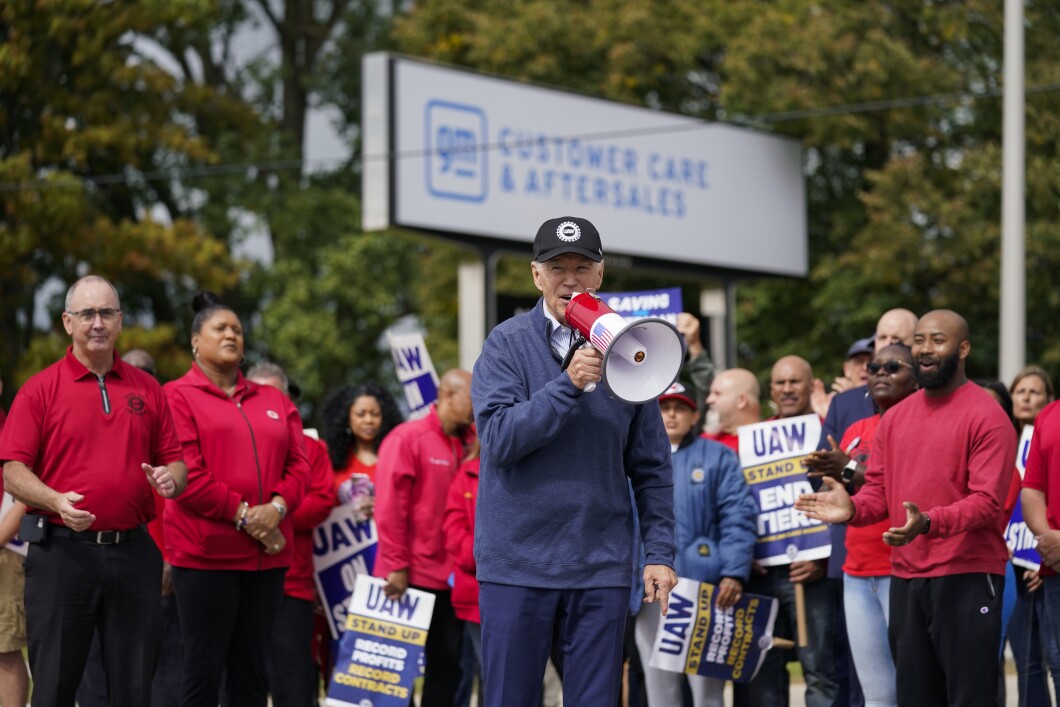
The United Auto Workers began striking on Sept. 15, holding up production at plants across the country as picketing employees demanded higher wages and better benefits. With no end in sight, automakers are losing money and taking steps away from electric vehicle manufacturing.
Since the beginning of the strike, the “Big Three” companies, Stellantis, General Motors, and Ford, continue to announce layoffs. They will reveal their next quarterly earnings on Tuesday.
RETIREMENT AGE RISE A TOUGH POLITICAL SELL DESPITE SOCIAL SECURITY FUNDING SCARE
Here are three things learned so far from the UAW strike as it enters its sixth week.

Companies slowing EV production as organized labor groups rebel
The production of electric vehicles is at the heart of the UAW strike, as members argue a push for EVs would come at the expense of fair wages and union jobs.
In addition to demanding union representation at new electric battery plants, the UAW lodged complaints against the automakers over unfair wages and pensions, demanded a four-day workweek with overtime pay beyond 32 hours, union representation at new electric battery plants, and the end of employment tiers.
Several automakers in recent weeks have halted their full-steam-ahead approach to electric vehicles. General Motors announced last week the company plans to delay production on the Chevrolet Silverado and GMC Sierra electric pickup trucks at a plant in Michigan for a year.
GM cited flattening demands for EVs. Ford said last week that it plans to cut one of three shifts at the plant that constructs the electric F-150 Lightning pickup truck. This comes after the UAW made a surprise move last week and added a huge Ford pickup truck and SUV plant in Louisville, Kentucky, to the strike list.

UAW and automakers are no closer to a deal
There are now 34,000 union workers already on strike. UAW President Shawn Fain, who usually announces strikes on Fridays, announced on Oct. 20 that there will be no new strikes for the sixth week. However, Fain said the UAW could announce new strikes at any time.
As of now, strikes are occurring across six assembly plants and 38 parts distribution warehouses.
General Motors and UAW continue to battle over contract negotiations. GM posted a video last week indicating there is still a significant distance between the auto manufacturers and the union. GM has offered a total wage package that includes a 20% pay increase over four years (UAW wants 36%) and brings most workers to a top wage of $39.24.
Gerald Johnson, the company’s global head of manufacturing, said GM could not meet “every demand Shawn Fain is asking for” because the company needs “profits to invest in our future.”
“If we don’t have those profits to continue our investments in our plants, our people and our products, we will be facing declining market share, an inability to fund the EV transition, and an inability to compete with a growing number of competitors right here in America,” Johnson said.
Ford and Stellantis have made similar comments, with Ford stating last week that it has reached the limit on how much it can spend to settle the strike with UAW.
Stellantis laid off 68 workers at a plant in Ohio in September, with “similar actions” expected for 300 employees at two plants in Indiana.
Fain said on Oct. 20 that he thinks the automakers can do more to meet the UAW’s demands.
“We’ve got cards left to play,” he said. “And they’ve got money left to spend.”

Visits from Biden and Trump did little to offer support
President Joe Biden made history after he made the first-ever presidential visit to a picket line in Michigan. Wearing a United Auto Workers cap, he said that the UAW “saved the auto industry” in 2008, and now that automakers are doing well, “you should be doing incredibly well, too.”
The next day, former President Donald Trump visited a nonunion parts plant across town for a campaign stop, stating that “I will be your protector” and “I will be your advocate, and I will be your greatest champion” if elected president in 2024.
However, shortly after their visits, Biden and Trump departed, leaving union workers with a feeling that both presidents had used the picket lines as endorsement opportunities and not as a genuine display of solidarity.
“They just want our endorsement. They talked a good game, but we’re still out here,” Mike Lowery, a 50-year-old production operator from Detroit, told the Washington Post while picketing outside a Stellantis facility in Center Line, Michigan. “We don’t want no politicians. They’re not helping us at all.”
And Biden needs the endorsements. Self-described as the most “pro-union” president, Biden has struggled to balance his goals on electric vehicles and clean energy without also alienating longtime allies in auto and manufacturing unions. Fain said the UAW is withholding its endorsement of Biden — despite giving him one in 2020 — until the president addresses certain concerns, including the auto industry’s transition to electric vehicles, job security, pay, and organizing.
“The one thing we’ve made clear is that our endorsements are going to be earned, not freely given,” Fain said in September. “It’s one thing we’re doing differently, and there’s a lot of work left to be done here.”
CLICK HERE TO READ MORE FROM THE WASHINGTON EXAMINER
Bill Bagwell, a 30-year GM employee, told the Washington Post that a visit from the president of the United States “doesn’t impress me.”
“He didn’t put any language in that grant to provide quality jobs with benefits and to help the community. He didn’t do any of that,” Bagwell said. “So it’s all show and no go, all flash and no gas.”





